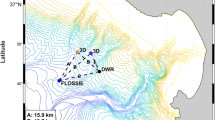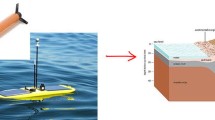Summary
In two closely spaced moorings in the Kiel Bight, four different current meterstwo rotor current meters (Aanderaa and Vector averaging), an acoustic current meter (designed by Gytre), and a pendulum current meter (designed by Niskin) were moored for 22 days. The Vector averaging current meter (VACM) was used as reference instrument on one mooring with the floatation at 7 m depth. The floatation of the second mooring was at 5 m depth in the first 17 days of the experiment, but in 2.7 m depth in the last 5 days to make their mooring more effected by surface waves. The Niskin wing current meter was most effected by wave-induced mooring motion. The Gytre instrument showed the smallest surface-wave effects. The vector variances of this instrument in 7.4 m depth on the surface-wave effected mooring and those of the VACM in 10 m depth on the reference mooring were about equal.
Zusammenfassung
In zwei benachbarten Verankerungen waren in der Kieler Bucht vier verschiedene Strommessertypen 22 Tage lang verankert. Es handelte sich um zwei Rotorstrommesser vom Typ Aanderaa und VACM (vektormittelnder Strommesser), einen akustischen Strommesser nach Gytre sowie um einen Pendelstrommesser nach Niskin. Das VACM-Gerät mit Auftrieb in 7 m Tiefe wurde als Bezugsinstrument verwendet. Während der ersten 17 Tage befand sich der Auftrieb der zweiten Verankerung in 5 m Tiefe. Um die Verankerung den Oberflächenwellen auszusetzen, wurde der Auftrieb während der letzten 5 Tage auf 2,7 m Tiefe verlegt. Der Niskin-Flügelstrommesser wurde am meisten von der welleninduzierten Verankerungsbewegung beeinflußt. Das Gytre-Instrument zeigte den geringsten Oberflächenwelleneffekt. Die Vektorvarianz dieses Gerätes an der oberflächenbeeinflußten Verankerung in 7,4 m Tiefe war ungefähr dieselbe wie diejenige des VACM-Gerätes auf 10 m Tiefe in der Bezugsverankerung.
Résumé
Sur deux sites très voisins de la Baie de Kiel, quatre courantomètres de types différents ont été mouillés pendant 22 jours: Deux à rotor (Aanderaa et à «intégration vectorielle» (VACM)), un acoustique (conçu par Gytre) et un à ailettes (conçu par Niskin). Le courantomètre VACM fut utilisé sur le premier site comme instrument de référence avec une immersion de 7 m. Sur le second site, l'immersion a été de 5 m pendant les 17 premiers jours de l'expérience mais ramenée à 2,7 m dans les 5 derniers jours pour rendre les mouillages plus sensibles aux mouvements de surface. Le courantomètre à ailettes Niskin se révèla le plus sensible aux effets dûs à la houle. Le Gytre se montra le moins sensible à ces mouvements. Les fluctuations de cet instrument à l'immersion 7,4 m étaient à peu près égales à celles du VACM à 10 m, sur le site de référence.
Similar content being viewed by others
References (a) Manufacturer's instruction manuals
Aanderaa: Operating manual for recording current meter. Serial no. 42-66, [undated], I.R. Aanderaa, nesttun, Norway.
Gytre acoustic current meter: A profiling oceanographic data collecting instrument. Chr. Michelsen Institute Ref. 75100-1, Bergen, Norway (1976).
Niskin wing current meter: Current meter model 6011 instruction manual. General Oceanics Inc., Miami, Florida, U.S.A. (1976).
VACM: Vector averaging current meter. AMF Electrical Products Development Division of AMF Inc. Alexandria, Virginia, U.S.A. (1973).
(b) Other references
Aanderaa, J., 1964: A recording and telemetering instrument. Techn. Rep. NATO Subcommitt. Oceanogr. Res. No. 16, 46 S., 20 Abb.
Beardsley, R. C., W. Boicourt, L. C. Huff, et al., 1977: CMICE 76: A current meter intercomparison experiment conducted off Long Island in February–March 1976. Techn. Rep. Woods Hole Oceanogr. Instn 77-62, 123 pp. [unpublished manuscript].
Bonde, L. W., 1978: Comparative testing of Niskin and vector averaging current meters. Techn. Rep. U. S. Office of Naval Res. No. TR 4618-0001, 17 pp.
Collar, P. G. and T. J. P. Gwilliam, 1977: Some laboratory measurements on an acoustic current meter developed at Christian Michelsen Institute, Norway. Rep. Inst. Oceanogr. Sci.47, 15 pp.
Dahl, D., 1969: The capability of the Aanderaa recording and telemetering instrument. In: Progress in Oceanography5 (M. Sears, ed.), Pergamon Press, pp. 103–106.
Geyer, D., 1964: Eigenschwingungen und Erneuerung des Wassers in der Eckernförder Bucht unter besonderer Berücksichtigung der Sturmlage vom 5.–6. Dezember 1961. Ph. D. Thesis, Univ. Kiel, 58 pp.
Gould, W. J. and E. Sambucco, 1975: The effect of mooring type on measured values of ocean currents. Deep-Sea Res.22, 55–62.
Gytre, T., 1976: The use of a high sensitivity ultrasonic current meter in an oceanographic data aquisation system. Radio Electron. Eng.46, 617–623.
Halpern, D., R. D. Pillsbury and R. L. Smith, 1974: An intercomparison of three current meters operated in shallow water. Deep-Sea Res.21, 489–497.
Halpern, D. and R. D. Pillsbury, 1976: Near-surface moored current meter measurements. Mar. Technol. Soc. J.10, 32–38.
McCullogh, J. R., 1975: Vector averaging current meter speed calibration and recording technique. Techn. Rep. Woods Hole Oceanogr. Instn 75-44, 35 pp. [unpublished manuscript].
Quadfasel, D. and F. Schott, 1979: Comparison of different methods of current measurements. Dt. hydrogr. Z.32, 27–38.
Rumohr, H., 1979: Hydrographische Dauerregistrierungen bei Boknis Eck (20 mI), westliche Ostsee von 1975–1978. Rep. Sonderforschungsbereich 95, Kiel. 59 pp.
Saunders, P. M., 1976: Near-surface current measurements. Deep-Sea Res.23, 249–258.
Unesco, 1969: An intercomparison of some current meters. I. SCOR Working Group 21. Unesco Techn. Pap. Mar. Sci.11, 70 pp.
Unesco, 1974: An intercomparison of some current meters. II. SCOR Working Group 21. Unesco Techn. Pap. Mar. Sci.17, 61 pp.
Unesco, 1975: An intercomparison of some current meters. III. SCOR Working Group 21. Unesco Techn. Pap. Mar. Sci.23, 42 pp.
Walden, R. G., C. W. Collins, jr., P. R. Clay, et al., 1977: Validation testing of the DOCMS intermediate mooring. Techn. Rep. Woods Hole Oceanogr. Instn 77-53, 95 pp. [unpublished manuscript].
Author information
Authors and Affiliations
Rights and permissions
About this article
Cite this article
Kuhn, H., Quadfasel, D., Schott, F. et al. On simultaneous measurements with rotor, wing and acoustic current meters, moored in shallow water. Deutsche Hydrographische Zeitschrift 33, 1–18 (1980). https://doi.org/10.1007/BF02225955
Received:
Issue Date:
DOI: https://doi.org/10.1007/BF02225955




